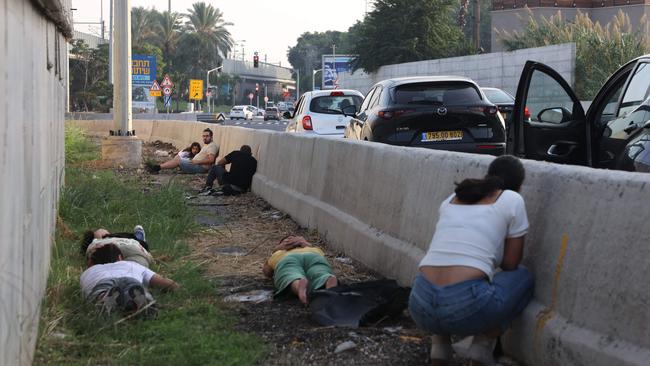Humane hope is conflict ends with swift elimination of Hamas

Last week, former minister for defence materiel Mike Kelly and former ambassador to Israel Dave Sharma encouraged Australians to support the Victims of Terror fund for survivors and victims of the Hamas October 7 massacre and kidnapping of Israeli civilians. The appeal will benefit all Israeli victims of this terror act, be they Jewish, Arab, Bedouin or Muslim.
The response to that Hamas massacre is war. In most wars, casualties of civilians are double those of combatants. In contrast, past Hamas conflicts with Israel provoked limited Israeli responses: 85 per cent of Gazan casualties were Hamas combatants struck in pinpoint military operations.
Statistics provided by the Hamas Ministry of Health in Gaza don’t tell us how many Gazan casualties are actually Hamas combatants but the brutal reality is that as the ground phase of the war looms, Gazan civilian casualties will increase alongside Hamas combatants. In urban operations, civilians are found near military objectives.
Hamas will seek to exploit its extensive sub-surface tunnel infrastructure developed over many years, especially under Gaza City, along with widespread booby trapping, mines, sniper nests, and suicide bombers. Its rocket launching units, supply depots, weapons dumps, communications and control centres and leadership are located in or under civilian buildings. The most important Hamas military leadership bunker is in the basement of Shifa hospital.
This situation strains the application of the international law principle of “distinction”, which requires separation between combatants and civilians.
When a Palestinian Islamic Jihad rocket misfired into the carpark of the Al-Ahli Arab hospital in Gaza, Hamas blamed Israel for a breach of the principle of distinction and alleged a war crime of targeting civilians.
Internationally corroborated evidence showed it was caused by the Islamic Jihad misfire.
While Israel routinely exercises target caution to prevent and reduce the numbers of Gazan civilians being struck by its missiles, Hamas is still firing large numbers of rockets incapable of accurate targeting into Israeli cities with no attempt to direct these weapons at military targets. They indiscriminately target Israeli civilians. This is a war crime.
In connection with the anticipated ground operation, effective advance warning has been given to Gazan civilians to move south from Gaza City away from the danger area. The opportunity to leave has been given over several days. Warnings by leaflets, radio and by telephone and SMS messaging have been used.
Satellite images show Hamas roadblocks and attacks on fleeing Gazans as punishment for disobeying their instructions not to leave Gaza City. Hamas seeks to create a human shield for its infrastructure and combatants to obstruct Israel’s attack: it couldn’t care less about the consequences for Gaza’s population.
Israel is in the process of evacuating its own citizens from northern Israel, near the border with Lebanon, in addition to those who have been evacuated from the south of the country near Gaza. So far, 120,000 have been evacuated.
In past conflicts up to two million have been evacuated, equivalent to the entire population of Gaza. Israel provides for the humanitarian needs of its own populations displaced in wartimes through diverse means, particularly the voluntary efforts of civil society.
Similar major humanitarian imperatives prevail in evacuating civilians from Gaza City to the south of Gaza. The international community, in particular Egypt, must ensure these needs are catered for through the Rafah Crossing into Egypt, which it controls.
The international law rule of proportionality in warfare is also relevant here. It forbids attacks expected to result in excessive loss of civilian life that is disproportionate to the direct military advantage anticipated. Israel is conducting a war to defeat a Hamas threat prevalent across a large area of Gaza.
It’s not collective punishment against the Gazan population to defeat Hamas. Israeli efforts to evacuate civilians and to protect a humanitarian corridor for essential supplies demonstrate that. It is about the proportionate force necessary to defeat an embedded military enemy.
When an extreme violent aggression presents against a country, as it is against Israel, proportionate measures required in self-defence may fall with a heavier weight on the aggressor.
Hamas’s 1988 Covenant makes clear that its aim is the complete destruction of the state of Israel and the annihilation of all Jews. As Hamas presents a more credible threat now, greater force against it becomes proportionate.
The humane hope is this war ends as soon as possible, with as few casualties as possible, and with elimination of Hamas from Gaza. The alternative, a ceasefire and sustainment and maintenance of Hamas rule, will indefinitely perpetuate the suffering of Israelis and Gazans.
Anthony Bergin is a senior fellow at Strategic Analysis Australia. Greg Rose is professor of law at the University of Wollongong.



In war, the humanitarian needs of a civilian population caught in the crossfire need to be met. A multitude of humanitarian actors play essential roles.